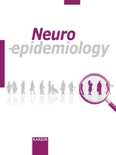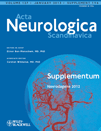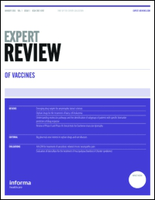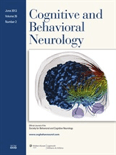
NEUROEPIDEMIOLOGY
Scope & Guideline
Pioneering Insights into Neurological Disorders.
Introduction
Aims and Scopes
- Epidemiological Research on Neurological Disorders:
The journal primarily emphasizes the epidemiology of various neurological conditions, such as stroke, dementia, multiple sclerosis, and traumatic brain injuries, exploring factors influencing their prevalence, incidence, and outcomes. - Health Economics and Cost-Effectiveness Analysis:
Research often includes economic evaluations related to neurological diseases, assessing the cost-effectiveness of interventions and the economic burden of these conditions on healthcare systems. - Longitudinal and Cohort Studies:
A significant focus is placed on longitudinal studies that track the progression of neurological diseases over time, providing insights into risk factors and long-term health outcomes. - Systematic Reviews and Meta-Analyses:
The journal frequently publishes systematic reviews and meta-analyses that synthesize existing literature, offering comprehensive overviews of specific topics within neuroepidemiology. - Global and Regional Health Perspectives:
Neuroepidemiology explores neurological health from a global perspective, investigating disparities in disease burden and healthcare access across different regions and populations. - Interdisciplinary Approaches:
The journal encourages interdisciplinary research that combines neurology, epidemiology, public health, and social sciences to address complex health issues related to neurological disorders.
Trending and Emerging
- Impact of COVID-19 on Neurological Health:
There is a significant increase in studies exploring the neurological implications of COVID-19, including its association with conditions such as long COVID, stroke, and other neurological manifestations. - Gender and Socioeconomic Disparities in Neurology:
Emerging research is increasingly focusing on gender and socioeconomic disparities in neurological diseases, emphasizing how these factors influence disease prevalence and management. - Integration of Machine Learning and Big Data in Epidemiology:
The use of machine learning and big data analytics is on the rise, allowing for more sophisticated analyses of large datasets to identify patterns in neurological disease risk and outcomes. - Chronic Disease Management and Economic Evaluations:
A growing emphasis on chronic disease management approaches and economic evaluations reflects a trend towards understanding the long-term implications of neurological disorders on healthcare systems. - Environmental and Lifestyle Factors in Neurological Disorders:
Research is increasingly examining the roles of environmental exposures and lifestyle factors (such as diet, exercise, and smoking) in the epidemiology of neurological diseases, highlighting the importance of preventive measures.
Declining or Waning
- Traditional Neurological Conditions without Novel Insights:
Research on well-established neurological conditions, such as classic stroke epidemiology, seems to be declining, particularly studies that do not introduce new methodologies or insights into existing knowledge. - Focus on Acute Neurological Events:
There appears to be a waning interest in acute neurological events that do not lead to long-term studies or chronic disease management, indicating a shift towards chronic disease epidemiology. - Single-Country Studies:
The prevalence of studies that focus exclusively on single-country data without comparative analysis or broader implications is decreasing, as there is a growing emphasis on global health perspectives. - Underrepresentation of Rare Neurological Disorders:
Research attention towards rare neurological disorders and their epidemiology seems to be diminishing, possibly overshadowed by more prevalent conditions that have broader public health impacts. - Demographic Specificity in Epidemiological Studies:
There is a noticeable reduction in research specifically targeting demographic subsets, indicating a move towards more generalized population studies rather than those focusing on specific groups.
Similar Journals

International Journal of Noncommunicable Diseases
Driving excellence in NCD research and policy.The International Journal of Noncommunicable Diseases, published by Wolters Kluwer Medknow Publications, is a leading open-access journal dedicated to advancing research in the field of noncommunicable diseases (NCDs). Since its inception in 2016, the journal has provided a robust platform for the dissemination of high-quality studies, reviews, and case reports that address the growing burden of NCDs globally. With a commitment to enhancing knowledge and understanding, the journal aims to navigate the complexities of prevention, diagnosis, management, and policy implications related to diseases such as diabetes, cardiovascular conditions, and cancers. The journal features an inclusive editorial board made up of renowned experts in the field, ensuring rigorous peer review and maintaining a high standard of scholarly excellence. As an open-access journal, it promotes widespread availability of its content, fostering collaboration and innovation among researchers, healthcare professionals, and students alike. Engage with the latest research and contribute to the growing body of knowledge in this critical area of public health by exploring the International Journal of Noncommunicable Diseases.

CANADIAN JOURNAL OF NEUROLOGICAL SCIENCES
Advancing Neurological Knowledge Since 1974Canadian Journal of Neurological Sciences, published by Cambridge University Press, stands as a reputable source of knowledge in the field of neurology, dedicated to advancing research and clinical practice. With an ISSN of 0317-1671 and an E-ISSN of 2057-0155, this journal has been a cornerstone for the exchange of ideas since its inception in 1974 and will continue to cater to the academic community until 2024. Recognized in the top quartile (Q2) in various categories including Medicine (miscellaneous) and Neurology (clinical), its articles engage a broad audience, ranging from established researchers to students seeking to deepen their understanding of neurological sciences. Although the journal is not an open-access publication, it provides vital insights and research findings that contribute significantly to its fields. With a Scopus rank of #183 in clinical neurology and a percentile ranking that reflects its commendable standing, the Canadian Journal of Neurological Sciences is indispensable for those committed to the exploration and treatment of neurological disorders.

METABOLIC BRAIN DISEASE
Connecting disciplines to combat brain disease.METABOLIC BRAIN DISEASE, published by SPRINGER/PLENUM PUBLISHERS, is a leading journal dedicated to advancing our understanding of the metabolic processes impacting brain health and disease. Established in 1986 and set to continue until 2024, this journal encompasses a wide range of interdisciplinary research that intersects the fields of Biochemistry, Cellular and Molecular Neuroscience, and Neurology, as evidenced by its notable quartile placements in Q2 and Q3 for 2023. With an ISSN of 0885-7490 and an E-ISSN of 1573-7365, it serves as a vital resource for researchers and practitioners aiming to deepen their insights into cerebral metabolic disorders and their implications. Although currently not an Open Access option, its rigorous peer-review process ensures that high-quality, impactful research reaches its audience. Showcasing a significant rank within the top percentile of its categories, METABOLIC BRAIN DISEASE is instrumental in shaping the future of neurological research and clinical applications.

ACTA NEUROLOGICA SCANDINAVICA
Pioneering Research in NeurologyACTA NEUROLOGICA SCANDINAVICA is a prestigious journal published by Wiley that has significantly contributed to the field of neurology and neuroscience since its inception in 1961. With a broad scope encompassing clinical and experimental research, this journal is esteemed for its rigorous peer-review process and high-quality publications. Located in the United Kingdom, it is recognized in the 2023 category quartiles as Q1 in Medicine (miscellaneous) and Q2 in both Neurology and Clinical Neurology, indicating its strong influence and relevance within the medical community. With an H-index demonstrating consistent citation impact, ACTA NEUROLOGICA SCANDINAVICA holds a Scopus rank of #86 out of 400 in Clinical Neurology, reflecting its contribution to advancing current knowledge and practice. Researchers, professionals, and students alike will find in this journal a valuable resource for the latest findings, discussions, and developments in understanding neurological disorders and treatments, furthering educational and clinical endeavors alike.

ACTA NEUROLOGICA BELGICA
Bridging Research and Practice in Neurology.ACTA NEUROLOGICA BELGICA is a leading academic journal published by Springer Heidelberg, dedicated to advancing the field of neurology and medicine. With an ISSN of 0300-9009 and E-ISSN 2240-2993, this journal has been a vital resource since its inception, contributing significantly to neurological research and clinical practice. It holds a respectable impact factor with categories spanning from Q2 in Medicine (miscellaneous) to Q3 in Neurology (clinical) as of 2023, indicating its prominence in the scientific community. The journal's extensive coverage since 1959 enhances its historical relevance, while its ongoing publication until 2024 ensures the latest developments are readily accessible. Researchers and practitioners can benefit from its rigorous peer-reviewed articles, which are crucial for staying current in this rapidly evolving discipline. As a scholarly platform, ACTA NEUROLOGICA BELGICA plays a pivotal role in disseminating knowledge and fostering innovation in neurology, making it a must-read for professionals, students, and anyone involved in the field.

Expert Review of Vaccines
Transforming Vaccine Development with Cutting-Edge Research.Expert Review of Vaccines, published by Taylor & Francis Ltd, is a pivotal open access journal that has established itself as a leading source of peer-reviewed articles focusing on vaccine research, development, and policy. With an impressive categorization in the top quartile (Q1) across various domains including Drug Discovery, Immunology, Molecular Medicine, and Pharmacology for 2023, this journal plays a crucial role in disseminating high-quality scientific findings that drive advances in the field. Located in the United Kingdom, it serves a global audience of researchers, healthcare professionals, and students seeking to stay abreast of cutting-edge developments in vaccination strategies and technologies. The journal’s Scopus ranks further attest to its excellence, boasting remarkable placements in Pharmacology and Drug Discovery, reflecting its impact and reach. Since transitioning to an open access format in 2023, the journal has enhanced accessibility to vital research, empowering a broader audience to contribute to and engage with the discourse surrounding vaccines. As the field of immunization continues to evolve, Expert Review of Vaccines remains a cornerstone for those committed to advancing knowledge and practice in this essential area of health science.

Cognitive and Behavioral Neurology
Advancing the Frontiers of Cognitive and Behavioral NeurologyCognitive and Behavioral Neurology is a prominent peer-reviewed journal dedicated to advancing the understanding of cognitive and behavioral aspects of neurological disorders. Published by Lippincott Williams & Wilkins, this journal has established itself as a vital resource for researchers, clinicians, and students in the fields of cognitive neuroscience, neuropsychology, and psychiatry. With an ISSN of 1543-3633 and an E-ISSN of 1543-3641, it offers a robust platform for the dissemination of high-quality research, as evidenced by its positioning in the Q3 quartiles across various categories, including Cognitive Neuroscience and Psychiatry. The journal, which has been actively publishing since 2003, encourages innovative studies that explore the intersection of cognition and behavior in neurological contexts. As a vital contributor to the academic dialogue on these topics, it provides an essential archive of findings and discussions that inform clinical practice and educational approaches, reflecting its commitment to improving patient outcomes and enhancing neurological science.

Current Neurology and Neuroscience Reports
Exploring the Depths of the Nervous SystemCurrent Neurology and Neuroscience Reports, published by Springer, is a leading peer-reviewed journal dedicated to advancing the field of neurology and neuroscience. With a notable impact factor and a reputable standing in the academic community, as evidenced by its Q1 rankings in both Neurology (Clinical) and Neuroscience (Miscellaneous) for 2023, this journal is ranked #49 out of 400 in clinical neurology and #21 out of 113 in general neuroscience, placing it in the 87th and 81st percentiles respectively.
Since its inception in 2001, it has provided a platform for groundbreaking research, comprehensive reviews, and critical insights into contemporary issues affecting the nervous system. Aimed at researchers, clinicians, and students alike, Current Neurology and Neuroscience Reports fosters interdisciplinary dialogue and knowledge exchange, addressing a broad spectrum of topics from clinical neurology to theoretical neuroscience. By publishing high-quality research, the journal not only contributes to the scientific community but also aims to enhance patient care and inform clinical practices. As a vital resource in neurological research, it invites contributions from a diverse range of studies to expand understanding in this ever-evolving field.

CESKA A SLOVENSKA NEUROLOGIE A NEUROCHIRURGIE
Exploring the Frontiers of Neurology and NeurosurgeryCESKA A SLOVENSKA NEUROLOGIE A NEUROCHIRURGIE is a prominent scientific journal focusing on the fields of neurology and neurosurgery, published by the esteemed Czech Medical Society. Since its inception in 1973, the journal has aimed to disseminate significant research and advancements in clinical neurology and surgery, contributing to the body of knowledge for professionals and researchers in these fields. Operating under a non-open access model, it maintains a dedicated readership interested in valuable insights from the latest studies and clinical practices. The journal is currently classified in the Q4 category in both Neurology (Clinical) and Surgery, reflecting its ongoing efforts to provide a platform for impactful research, despite being ranked in the lower percentiles within Scopus. Based in Prague, Czech Republic, this journal not only serves as a repository of clinical findings but also encourages collaboration and scholarly dialogue among neurologists and neurosurgeons, driving the field towards further innovations in patient care. With coverage extending from 1973 to 2024, it stands as a key resource for those committed to advancing neurological and surgical sciences.

BMC HEALTH SERVICES RESEARCH
Illuminating pathways to better health systems.BMC Health Services Research is a leading open-access journal dedicated to advancing the field of health policy and services research. Published by BMC since 2001 and based in the United Kingdom, this journal has established itself as an essential resource for researchers, professionals, and students alike, fostering a deeper understanding of health care systems and policies. With an impressive 2023 Q1 ranking in the Health Policy category and a Scopus rank of 90/310, it clearly demonstrates its commitment to high-quality, impactful research. The journal's open-access model ensures that research findings are accessible to a global audience, promoting collaboration and innovation in health services. Spanning from 2001 to 2024, BMC Health Services Research is poised to remain at the forefront of health services research, making significant contributions to policy formulation and practice improvement in the healthcare sector.